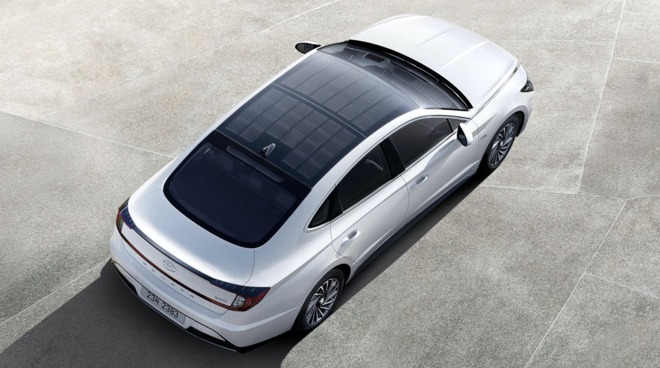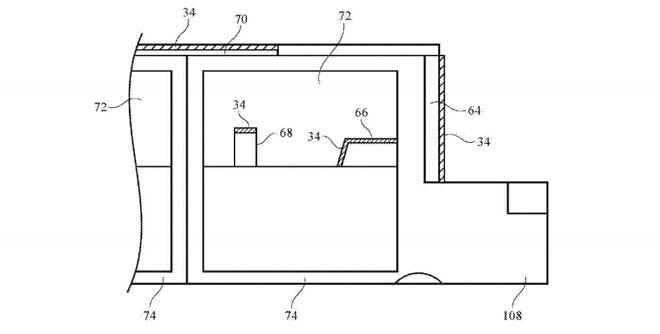Apple Car solar panel technology could also be used in Apple Watch, iPhone case
Apple's future car may have photovoltaic solar panels on the roof to maximize range and idle charging speed, but it may not stop there. The company believes that an extension of the technology would be well-suited to the Apple Watch, the iPhone, and other device cases.

Hyundai is one of a few car manufacturers to offer solar panels built into a car.
A problem that the vast majority of portable electrical devices have is a need to recharge the batteries. Users, from time to time, have to undergo the chore of plugging their iPhone into a wall outlet, or placing it on a wireless charging pad to regain power.
In the case of an electric car, such as the rumored Apple car, drivers have to go to a specific charging station on a long road trip and wait for long periods to acquire more charge. Even at a destination, there is no guarantee that charging facilities will be available, leaving the prospect of an electric car being parked up without any ability to top up its electrical fuel reserves.
In a patent granted to Apple by the U.S. Patent and Trademark Office on Tuesday titled "Systems with photovoltaic cells," Apple simply suggests applying solar panels to products that need recharging, to allow a gradual trickle recharge of power over time.
In general, Apple proposes the use of a material made from intertwined stands, with some of the strands made up of conductive strands. The conductive elements connect a recharging system of a device to a photovoltaic cell, mounted onto the material.
To ensure optimal power flow, the conductive strands have to be separated by insulating strands, eliminating any contact between conductive elements throughout the fabric.

An illustration indicating areas on a car that the thin-film photovoltaic cells could be applied.
While the photovoltaic cell could be a fixed element, Apple also proposes the use of a thin-film photovoltaic cell deposited onto the flexible material, allowing the 1 to 10 microns-thick film to confirm to the shape of a casing. The material in question can include fabrics, polymers, and leathers, the patent suggests.
Apple also believes that the solar panel flexible material could be incorporated into headphones or a cover for an electronic device. Other items that may benefit from the system mentioned in the filing include a "wristwatch device" like an Apple Watch, a "device embedded in eyeglasses or other equipment worn on a user's head," and "in an automobile."
Drawings included in the patent directly depict the use of photovoltaic panels on headphones and a vehicle. In the latter case, the use of such panels would be beneficial as it would be expected a car would be outdoors and exposed to the sun for long stretches of time, and would provide an opportunity to recharge whenever it is in use or parked externally.
Adding solar panels to a car roof is not a new concept, with some manufacturers already offering them on vehicles. In Apple's version, the film would plausibly be placed all over a vehicle, and as depicted in one image, even covering a window, suggesting it may be transparent or sufficiently translucent enough for that purpose.
The patent lists its inventors as Joseph B. Walker, Kathleen A. Bergeron, and Daniel D. Sunshine. Bergeron has been previously linked to a haptic feedback system for the Apple Pencil, while Sunshine is named in filings relating to smart Apple Watch straps and adjustable smart fabric.

Apple proposes the use of the solar panels on the headband and earcups of headphones.
Apple files numerous patent applications on a weekly basis, but while the existence of a filing indicates areas of interest for Apple's research and development teams, it does not guarantee the concepts described will appear in a future product or service.
The Apple Car has been long rumored to be under development, under the title "Project Titan" alongside Apple's self-driving vehicle testing. Though autonomous driving has taken the most attention, many filings have surfaced revealing Apple has ambitions to redesign the automobile in a number of surprising ways.
These include sunroof designs using a large glass panel and a multi-segmented iteration, headlight systems that could highlight road hazards, in-car illumination systems that use TrueTone technology, and smart seatbelts among others. On power, Apple has suggested the idea of peloton of cars that could share energy between vehicles, wireless charging systems, battery floors, and even a small robot that plugs a charging cable underneath a vehicle.
Apple's suggested use of conductive strands have also floated around for a while in patent filings, including one from January 2019 explaining how the strands could be woven to create contact points to more seamlessly embed sensors and components into clothing and fabric-based accessories.

Hyundai is one of a few car manufacturers to offer solar panels built into a car.
A problem that the vast majority of portable electrical devices have is a need to recharge the batteries. Users, from time to time, have to undergo the chore of plugging their iPhone into a wall outlet, or placing it on a wireless charging pad to regain power.
In the case of an electric car, such as the rumored Apple car, drivers have to go to a specific charging station on a long road trip and wait for long periods to acquire more charge. Even at a destination, there is no guarantee that charging facilities will be available, leaving the prospect of an electric car being parked up without any ability to top up its electrical fuel reserves.
In a patent granted to Apple by the U.S. Patent and Trademark Office on Tuesday titled "Systems with photovoltaic cells," Apple simply suggests applying solar panels to products that need recharging, to allow a gradual trickle recharge of power over time.
In general, Apple proposes the use of a material made from intertwined stands, with some of the strands made up of conductive strands. The conductive elements connect a recharging system of a device to a photovoltaic cell, mounted onto the material.
To ensure optimal power flow, the conductive strands have to be separated by insulating strands, eliminating any contact between conductive elements throughout the fabric.

An illustration indicating areas on a car that the thin-film photovoltaic cells could be applied.
While the photovoltaic cell could be a fixed element, Apple also proposes the use of a thin-film photovoltaic cell deposited onto the flexible material, allowing the 1 to 10 microns-thick film to confirm to the shape of a casing. The material in question can include fabrics, polymers, and leathers, the patent suggests.
Apple also believes that the solar panel flexible material could be incorporated into headphones or a cover for an electronic device. Other items that may benefit from the system mentioned in the filing include a "wristwatch device" like an Apple Watch, a "device embedded in eyeglasses or other equipment worn on a user's head," and "in an automobile."
Drawings included in the patent directly depict the use of photovoltaic panels on headphones and a vehicle. In the latter case, the use of such panels would be beneficial as it would be expected a car would be outdoors and exposed to the sun for long stretches of time, and would provide an opportunity to recharge whenever it is in use or parked externally.
Adding solar panels to a car roof is not a new concept, with some manufacturers already offering them on vehicles. In Apple's version, the film would plausibly be placed all over a vehicle, and as depicted in one image, even covering a window, suggesting it may be transparent or sufficiently translucent enough for that purpose.
The patent lists its inventors as Joseph B. Walker, Kathleen A. Bergeron, and Daniel D. Sunshine. Bergeron has been previously linked to a haptic feedback system for the Apple Pencil, while Sunshine is named in filings relating to smart Apple Watch straps and adjustable smart fabric.

Apple proposes the use of the solar panels on the headband and earcups of headphones.
Apple files numerous patent applications on a weekly basis, but while the existence of a filing indicates areas of interest for Apple's research and development teams, it does not guarantee the concepts described will appear in a future product or service.
The Apple Car has been long rumored to be under development, under the title "Project Titan" alongside Apple's self-driving vehicle testing. Though autonomous driving has taken the most attention, many filings have surfaced revealing Apple has ambitions to redesign the automobile in a number of surprising ways.
These include sunroof designs using a large glass panel and a multi-segmented iteration, headlight systems that could highlight road hazards, in-car illumination systems that use TrueTone technology, and smart seatbelts among others. On power, Apple has suggested the idea of peloton of cars that could share energy between vehicles, wireless charging systems, battery floors, and even a small robot that plugs a charging cable underneath a vehicle.
Apple's suggested use of conductive strands have also floated around for a while in patent filings, including one from January 2019 explaining how the strands could be woven to create contact points to more seamlessly embed sensors and components into clothing and fabric-based accessories.

Comments
There are now thousands of employees at Apple whose “job” is to generate patents. Just like at IBM
I realize that solar powered watches do exist (Seiko, others), but those are non-smart watches that have tiny power needs. A full-blown smart watch is a whole 'nother story.
I travel often to rugged environments where fueling stations are minimal (and pricey) but at least they exist, unlike EV charging stations. One thing I like about Tesla's CyberTruck is that there's a solar panel that can give you a handful of extra miles per day. At the very least, I'd be able to slowly get back to civilization if the 500 mile range wasn't enough (although regenerative braking coming down a mountain would probably be enough to get me to the EV stations I'm aware of).
I hope this does come to the Watch. For some reason people on this site seem to feel that it needs to charge the device to full instantly or it's pointless, but if solar could at least offer the ability to read the time pretty much without fail, and a few hours during peak hours would let you make an emergency call or ping your location I'd be excited about that for safety.
And in the future these technologies will only improve. I can see a future where it becomes difficult to buy a new vehicle without this tbh. Imagine Apple or Tesla not needing to plug in to charge and others having to? It would catch on rapid fire. It would be like an iPhone that self-charges. Everyone would want one.
This guy has a few thoughts on this:
Yep. That plus 500 mile range was a big reason that I put a downpayment on one.
The car application is mostly just one of the examples for application in the patent app and has very little to do with patent imo. And yes, I most certainly want my car to be lined with solar PV surfaces. Has the potential to cut my commute costs in half, and add energy to the house with a bidirectional charger. Don't understand people who scoff at this idea. It will increase the efficiency of an EV for most or many owners by 10%, 20%, 30%, 50%, and even 100% depending on their usage and commute. Since when do we say efficiency improvements, even 10%, in this range isn't worth it?
https://lightyear.one
This was test driven on the Fully Charged channel on YouTube. The prototypes were getting about 75km of range if parked in the sun all day. The average commute is 25km (each way).
https://www.cascadia4x4.com/collections/vehicle-specific-hood-solar-panel